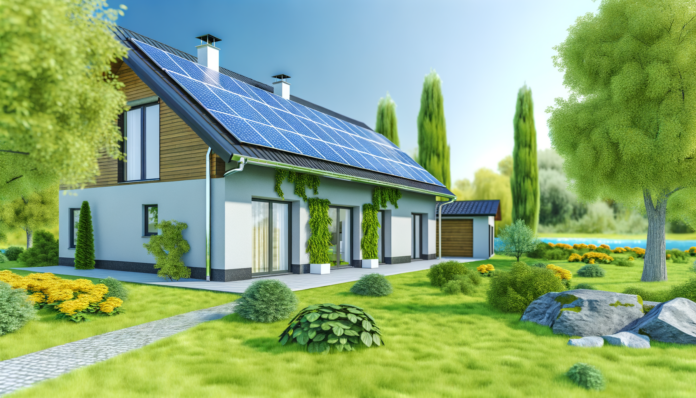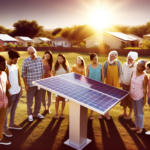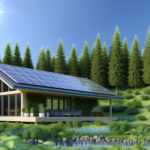Introduction to Solar Power
The Importance of Sustainability
In recent years, the urgency of adopting sustainable practices has become increasingly apparent. The global community is facing significant environmental challenges, including climate change, resource depletion, and pollution. These issues have prompted a shift towards more sustainable energy sources to mitigate their impact. Solar power, as a renewable and clean energy source, plays a crucial role in this transition. By harnessing the abundant energy from the sun, we can reduce our reliance on fossil fuels, decrease greenhouse gas emissions, and promote a healthier planet for future generations.
What is Solar Power?
Solar power is the conversion of sunlight into electricity using photovoltaic (PV) cells or concentrated solar power (CSP) systems. PV cells, commonly known as solar panels, are made of semiconductor materials that generate electricity when exposed to sunlight. CSP systems, on the other hand, use mirrors or lenses to concentrate sunlight onto a small area, producing heat that can be used to generate electricity. Both technologies offer a sustainable and renewable way to produce energy, making them essential components of the global shift towards cleaner energy sources.
Benefits of Solar Energy
The adoption of solar energy offers numerous benefits, both for individuals and society as a whole. Here are some of the key advantages:
- Environmental Benefits: Solar energy is a clean and renewable source of power that significantly reduces greenhouse gas emissions and air pollution. Unlike fossil fuels, solar power does not produce harmful byproducts, making it an environmentally friendly option.
- Economic Savings: While the initial investment in solar panels can be substantial, the long-term savings on energy bills are considerable. Solar energy systems can reduce or even eliminate electricity costs, providing a high return on investment over time.
- Energy Independence: By generating their own electricity, individuals and businesses can reduce their dependence on the grid and protect themselves from rising energy prices. This energy independence also enhances resilience against power outages and energy supply disruptions.
- Job Creation: The solar industry has become a significant source of employment, creating jobs in manufacturing, installation, maintenance, and research. This growth in the renewable energy sector contributes to economic development and job security.
- Scalability and Versatility: Solar energy systems can be scaled to meet various energy needs, from small residential installations to large commercial and industrial projects. Additionally, solar technology can be integrated into a wide range of applications, including portable chargers, solar-powered vehicles, and off-grid systems.
- Government Incentives: Many governments offer incentives, rebates, and tax credits to encourage the adoption of solar energy. These financial benefits can significantly reduce the upfront costs of solar installations, making it more accessible to a broader audience.
In conclusion, solar power is a vital component of the global effort to achieve sustainability. Its environmental, economic, and social benefits make it an attractive and viable energy solution for individuals, businesses, and communities. By embracing solar energy, we can contribute to a cleaner, more sustainable future.
Understanding Solar Technology
How Solar Panels Work
Solar panels, also known as photovoltaic (PV) panels, convert sunlight directly into electricity. This process involves several key components and steps:
- Photovoltaic Cells: These cells are made from semiconductor materials, typically silicon. When sunlight hits these cells, it excites electrons, creating an electric current.
- Inverter: The direct current (DC) generated by the PV cells is converted into alternating current (AC) by an inverter, making it usable for household appliances and feeding into the grid.
- Mounting System: Solar panels are mounted on rooftops or ground systems to ensure they receive maximum sunlight exposure.
- Battery Storage: Excess energy can be stored in batteries for use during non-sunny periods, enhancing the reliability of solar power systems.
The efficiency of solar panels depends on factors such as the quality of the PV cells, the angle and orientation of the panels, and the amount of sunlight received.
Types of Solar Panels
There are several types of solar panels available, each with its own advantages and applications:
- Monocrystalline Panels: Made from a single crystal structure, these panels are known for their high efficiency and longevity. They are ideal for areas with limited space.
- Polycrystalline Panels: These are made from multiple silicon crystals and are generally less efficient than monocrystalline panels but are more cost-effective.
- Thin-Film Panels: Composed of layers of photovoltaic material on a substrate, thin-film panels are flexible and lightweight. They are less efficient but can be used in a variety of applications, including building-integrated photovoltaics (BIPV).
- Concentrated PV (CPV): These panels use lenses or mirrors to focus sunlight onto high-efficiency cells. They are suitable for areas with high direct sunlight and require tracking systems to follow the sun’s path.
Advancements in Solar Technology
Solar technology is continuously evolving, leading to increased efficiency and new applications:
- Perovskite Solar Cells: These emerging cells promise higher efficiency and lower production costs compared to traditional silicon-based cells. They are still in the research phase but show great potential.
- Bifacial Panels: These panels can capture sunlight on both sides, increasing energy production. They are particularly effective in areas with reflective surfaces like snow or water.
- Building-Integrated Photovoltaics (BIPV): Solar cells are integrated into building materials such as windows, facades, and roofs, making them a seamless part of the architecture.
- Solar Tracking Systems: These systems adjust the angle of the panels throughout the day to follow the sun, maximizing energy capture.
- Energy Storage Solutions: Advances in battery technology, such as lithium-ion and flow batteries, are improving the storage capacity and lifespan of solar energy systems, making them more reliable.
These advancements are making solar energy more accessible, efficient, and versatile, contributing significantly to the global shift towards sustainable energy solutions.
Solar Solutions for Outdoor Enthusiasts
Portable Solar Chargers
For outdoor enthusiasts, staying connected while off the grid is often a necessity. Portable solar chargers offer a convenient and eco-friendly solution to keep devices like smartphones, GPS units, and cameras powered up. These chargers are lightweight, compact, and designed to harness the sun’s energy efficiently.
- Convenience: Portable solar chargers are easy to carry and can be attached to backpacks, tents, or placed on a sunny spot to collect energy.
- Versatility: They come with multiple USB ports and adapters, making them compatible with a wide range of devices.
- Eco-Friendly: By using solar energy, these chargers reduce the need for disposable batteries and reliance on fossil fuels.
Solar-Powered Camping Gear
Camping gear powered by solar energy is revolutionizing the way we experience the great outdoors. From lighting to cooking, solar-powered equipment ensures that your camping trip is both sustainable and comfortable.
- Solar Lanterns and Lights: These provide reliable illumination without the need for batteries or fuel. Many models also come with USB ports for charging devices.
- Solar Cookers: These innovative devices use reflective panels to concentrate sunlight and cook food, eliminating the need for firewood or gas.
- Solar Showers: Portable solar showers heat water using the sun, offering a warm shower experience even in remote locations.
Solar Solutions for Boating
Boating enthusiasts can also benefit from solar technology. Solar panels can be installed on boats to power various systems, reducing the reliance on traditional fuel sources and enhancing the boating experience.
- Solar Panels for Boats: These can be mounted on the deck or roof to charge batteries that power navigation systems, lights, and other electronic devices.
- Solar-Powered Water Pumps: These pumps can be used for bilge pumping, water supply, and other essential functions, ensuring a smooth and eco-friendly boating experience.
- Solar Refrigerators: Keep your food and drinks cool without draining your boat’s battery, thanks to solar-powered refrigeration units.
By integrating solar solutions into outdoor activities, enthusiasts can enjoy the beauty of nature while minimizing their environmental impact. Whether you’re hiking, camping, or boating, solar technology offers a sustainable way to power your adventures.
Living Off-Grid with Solar Power
Setting Up a Solar-Powered Home
Transitioning to a solar-powered home is a significant step towards achieving energy independence and sustainability. The process begins with assessing your energy needs. This involves calculating the total wattage required to power your household appliances and devices. Tools like a Kill A Watt electricity usage monitor can help you measure the energy consumption of each appliance.
Once you have a clear understanding of your energy needs, the next step is to choose the right solar panel system. There are three main types of solar panels: monocrystalline, polycrystalline, and thin-film. Monocrystalline panels are the most efficient but also the most expensive, while thin-film panels are the least efficient but more affordable. Your choice will depend on your budget, space availability, and energy requirements.
The installation process involves mounting the solar panels on your roof or in an open area with maximum sun exposure. The panels are connected to an inverter, which converts the direct current (DC) generated by the panels into alternating current (AC) for home use. A battery bank is essential for storing excess energy, ensuring a continuous power supply even when sunlight is not available. For added reliability, some off-grid systems include a generator as a backup power source.
Solar Power for Remote Locations
Solar power is particularly advantageous for remote locations where access to the traditional power grid is either unavailable or prohibitively expensive. In these areas, solar energy provides a reliable and cost-effective solution for electricity needs.
Portable solar panels and solar generators are ideal for remote settings. These systems are easy to transport and set up, making them perfect for cabins, boats, and RVs. Portable solar chargers can power small devices like phones and laptops, while larger solar generators can handle more substantial energy needs, such as lighting, refrigeration, and even small appliances.
For remote homes, a more permanent solar installation is recommended. This involves setting up a solar array with sufficient capacity to meet the household’s energy demands. The system should include a robust battery bank to store energy for use during cloudy days or nighttime. Additionally, integrating a wind turbine or a micro-hydro system can provide supplementary power, enhancing the overall reliability of the energy supply.
Maintenance and Upkeep
Maintaining a solar power system is relatively straightforward but crucial for ensuring its longevity and efficiency. Regular maintenance tasks include cleaning the solar panels to remove dust, dirt, and debris that can reduce their efficiency. This is especially important in areas with high levels of pollution or frequent dust storms.
Inspecting the system for any signs of wear or damage is also essential. Check the wiring, connections, and mounting hardware to ensure everything is secure and functioning correctly. It’s advisable to perform these inspections at least twice a year or after severe weather events.
Battery maintenance is another critical aspect. For lead-acid batteries, regular checks of the electrolyte levels and ensuring proper ventilation are necessary to prevent overheating and prolong battery life. Lithium-ion batteries require less maintenance but should still be monitored for performance and capacity.
Inverter maintenance involves checking for any error codes or warning lights and ensuring the cooling system is functioning correctly. Keeping the inverter clean and free from dust will help maintain its efficiency.
By following these maintenance guidelines, you can ensure that your solar power system remains efficient and reliable, providing a sustainable energy solution for your off-grid lifestyle.
Economic and Environmental Impact
Cost Savings Over Time
Switching to solar power can lead to significant cost savings over time. While the initial investment in solar panels and installation can be substantial, the long-term benefits often outweigh these upfront costs. Solar energy systems typically have a lifespan of 25 to 30 years, during which they can drastically reduce or even eliminate electricity bills. The savings accumulate as homeowners and businesses no longer need to purchase as much electricity from the grid. Additionally, the cost of solar technology has been decreasing steadily, making it more accessible and affordable for a wider range of consumers.
Moreover, solar power systems require minimal maintenance, which further reduces ongoing costs. Unlike traditional energy sources that rely on fuel, solar energy harnesses the power of the sun, which is free and abundant. This means that once the system is installed, the primary costs are related to occasional maintenance and potential upgrades, rather than continuous fuel expenses.
Reducing Your Carbon Footprint
One of the most compelling reasons to transition to solar power is its positive impact on the environment. Solar energy is a clean, renewable resource that significantly reduces greenhouse gas emissions compared to fossil fuels. By generating electricity from the sun, solar panels help decrease the reliance on coal, oil, and natural gas, which are major contributors to air pollution and climate change.
The reduction in carbon footprint is substantial. For instance, a typical residential solar panel system can offset approximately 3 to 4 tons of carbon dioxide annually, which is equivalent to planting over 100 trees each year. On a larger scale, widespread adoption of solar energy can lead to a significant decrease in global carbon emissions, helping to mitigate the effects of climate change and promote a healthier environment.
Government Incentives and Rebates
To encourage the adoption of solar energy, many governments offer various incentives and rebates. These financial incentives can significantly reduce the initial cost of installing solar panels, making the transition more affordable for homeowners and businesses. Common incentives include tax credits, grants, and rebates.
In the United States, for example, the federal government offers the Investment Tax Credit (ITC), which allows homeowners and businesses to deduct a significant percentage of the cost of installing a solar energy system from their federal taxes. Additionally, many states and local governments provide their own incentives, such as property tax exemptions, sales tax exemptions, and performance-based incentives.
These incentives not only make solar power more accessible but also accelerate the return on investment. By taking advantage of these programs, consumers can reduce their payback period and start enjoying the financial benefits of solar energy sooner.
In conclusion, transitioning to solar power offers substantial economic and environmental benefits. The long-term cost savings, reduction in carbon footprint, and availability of government incentives make solar energy an attractive option for those looking to adopt a more sustainable lifestyle. As technology continues to advance and costs decrease, the adoption of solar power is likely to grow, contributing to a cleaner, more sustainable future.
Choosing the Right Solar Products
Factors to Consider
When selecting solar products, several factors should be taken into account to ensure you make the best choice for your needs. Here are some key considerations:
- Efficiency: The efficiency of solar panels determines how much sunlight is converted into usable electricity. Higher efficiency panels may cost more but can generate more power in a smaller space.
- Cost: Initial costs can vary widely. Consider not just the price of the panels but also installation, maintenance, and potential financing options.
- Durability: Look for panels with a long warranty and proven durability to withstand environmental factors like wind, rain, and snow.
- Energy Needs: Assess your energy consumption to determine the size and number of panels required. This will help you avoid over- or under-investing.
- Space Availability: The amount of available space on your roof or property will influence the type and number of panels you can install.
- Incentives: Research government incentives, rebates, and tax credits that can offset the initial investment.
Reading Reviews and Testimonials
Before making a purchase, it’s crucial to read reviews and testimonials from other consumers. Here’s why:
- Real-World Performance: Reviews can provide insights into how well the solar products perform in real-world conditions, beyond the manufacturer’s specifications.
- Customer Service: Testimonials often highlight the quality of customer service provided by the manufacturer or installer, which can be a critical factor in your overall satisfaction.
- Reliability: Consistent positive reviews can indicate reliable and durable products, while negative reviews can alert you to potential issues.
- Installation Experience: Reviews can offer valuable information about the installation process, including any challenges and how they were resolved.
Where to Buy
Finding the right place to purchase your solar products is just as important as choosing the products themselves. Here are some options:
- Specialized Solar Companies: These companies often provide a full range of services, from product selection to installation and maintenance. They can offer expert advice tailored to your specific needs.
- Home Improvement Stores: Major retailers like Home Depot and Lowe’s offer solar products and can sometimes arrange for professional installation. This can be a convenient option if you prefer a one-stop-shop experience.
- Online Retailers: Websites like Amazon and specialized solar marketplaces offer a wide range of products. Be sure to check reviews and ratings to ensure you’re buying from a reputable seller.
- Local Installers: Local solar installers often have partnerships with manufacturers and can provide competitive pricing along with personalized service. They are also familiar with local regulations and incentives.
By considering these factors, reading reviews, and choosing the right place to buy, you can make an informed decision that will help you transition to a sustainable, solar-powered lifestyle.
Future of Solar Power
Emerging Technologies
The future of solar power is being shaped by a wave of emerging technologies that promise to enhance efficiency, reduce costs, and expand the applications of solar energy. One of the most exciting developments is the advent of perovskite solar cells. These cells offer a cheaper and more efficient alternative to traditional silicon-based cells, with the potential to significantly lower the cost of solar energy. Additionally, advancements in organic and hybrid solar cells are opening new avenues for flexible and lightweight solar panels, which can be integrated into a variety of surfaces, including windows and clothing.
Another promising technology is concentrated solar power (CSP), which uses mirrors or lenses to concentrate sunlight onto a small area to generate heat, which is then used to produce electricity. CSP systems can incorporate thermal storage solutions, such as molten salts, allowing them to generate power even when the sun is not shining. This capability makes CSP a valuable complement to other renewable energy sources, providing a more stable and reliable energy supply.
Trends in Solar Energy
Several key trends are driving the growth and evolution of solar energy. One major trend is the increasing adoption of solar energy storage solutions. As battery technology improves, solar power systems are becoming more capable of storing excess energy generated during the day for use at night or during cloudy periods. This development is crucial for enhancing the reliability and resilience of solar power, making it a more viable option for both residential and commercial use.
Another trend is the rise of decentralized solar power systems. Instead of relying solely on large-scale solar farms, more communities and individuals are installing their own solar panels, often combined with battery storage. This shift towards decentralized energy production not only increases energy independence but also reduces the strain on the grid and enhances energy security.
The integration of solar power with smart grid technology is also gaining momentum. Smart grids use digital communication technology to manage electricity more efficiently, allowing for better integration of renewable energy sources like solar. This technology enables real-time monitoring and management of energy production and consumption, optimizing the use of solar power and reducing waste.
The Role of Solar in Global Sustainability
Solar energy plays a pivotal role in the global push towards sustainability. As a clean and renewable energy source, solar power helps reduce greenhouse gas emissions and mitigate climate change. By replacing fossil fuels with solar energy, we can significantly decrease the amount of carbon dioxide and other pollutants released into the atmosphere, contributing to a healthier and more sustainable environment.
Moreover, solar energy supports economic sustainability by creating jobs and stimulating economic growth. The solar industry has become a major employer, with millions of jobs created worldwide in manufacturing, installation, maintenance, and research. This job creation not only boosts local economies but also provides opportunities for skill development and career advancement.
Solar power also promotes social sustainability by improving energy access in remote and underserved communities. Off-grid solar solutions, such as solar home systems and mini-grids, provide reliable and affordable electricity to areas that are not connected to the main grid. This access to energy can transform lives, enabling better education, healthcare, and economic opportunities.
In conclusion, the future of solar power is bright, with emerging technologies and trends driving its growth and integration into our energy systems. As we continue to innovate and invest in solar energy, it will play an increasingly important role in achieving global sustainability goals, ensuring a cleaner, healthier, and more prosperous future for all.






